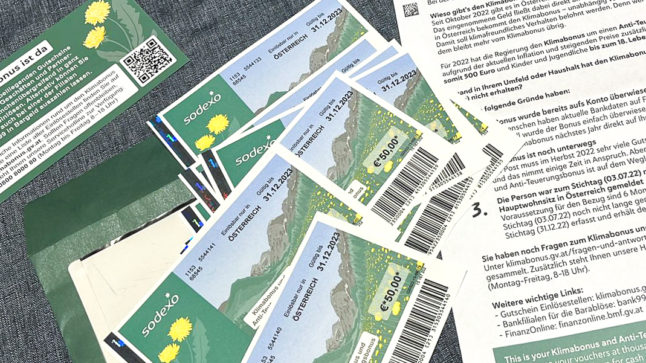When it comes to parental leave, Austria has one of the most extensive systems in the European Union and the world.
This is mainly because, when you consider all the combined benefits, parents can have paid leave for years – even if not on their full salary or working part-time. The system is also very flexible, with different options that parents can choose.
There are a few essential words and schemes that people looking to take parental leave in Austria should know. The Local talked with Severina Ditzov, legal advisor and co-founder of Austria for Beginners, to understand how parental leave and family benefits work in Austria.
Mutterschutz
In Austria, there is a period of Mutterschutz, or “maternity protection”, that starts eight weeks before the baby’s due date and continues for eight to 12 weeks after birth. The mothers are not supposed to work during this time, and companies need to follow this period strictly.
READ MORE: The smartphone apps that make living in Austria easier
During Mutterschutz, mothers receive an allowance known as Wochengeld.
For employed women, the amount of the maternity allowance is based on the net pay received in the last three calendar months before the start of maternity leave. Self-employed women who do not carry on a trade are entitled to a Wochengeld amounting to € 61.25 per day (values for 2023).
The process for the leave and the benefit is made by the company directly with the government, and the idea is to protect the pregnant woman.
When the child is born, fathers can take up to one month of unpaid leave, known as Papamonat (Daddy month). “This can be taken within the first three months of the birth of the child”, Ditzov explains.
The “daddy month” is considered unpaid leave, but fathers can ask for a up to a Familienzeitbonus payment of up to € 1,626.26 (equivalent of €55.46 a day) compensation from the state (for births from January 1st 2024). Certain companies will offer new dads a couple of days off paid after the birth, but this depends on the company and sector agreements in place.
Karenz
After the end of Mutterschutz, parents can ask to go on a Karenz, or parental leave period – the release from work in return for a suspension of wages.
Austria has a quite flexible scheme, and parents can switch twice between who takes the benefit. They can stay on Karenz for a total of two years, though the minimum period for parental leave is two months – and both parents need to take it in order to be entitled to the two years. There’s also a protection against employment termination that ends four weeks after the end of the parental leave.
During parental leave, the families receive government payments, known as Kinderbetreuungsgeld, depending on the scheme they choose.
READ MORE: Six helpful tips to save money on food shopping in Austria
It is possible to obtain a lump payment every month or a percentage of average salaries, and the actual amount will be calculated based on how long the parental leave will last. Parents who take longer leaves will receive a lower monthly allowance.
“The payment and the time on leave don’t need to match, so parents can choose to stay for two years on leave but only receive the payment for six months, for example,” says Ditzov.
Of course, that would mean the payments would be higher, even if for fewer months.
Persons who have not had gainful employment subject to compulsory insurance in Austria in the 182 calendar days preceding the child’s birth, which includes homemakers, and people who recently moved to Austria, will be entitled to the flat-rate childcare allowance.
“Even if you never worked in Austria before, as long as you follow certain requirements, mainly proving that your centre of living is in Austria, you are entitled to the flat-rate payment”, Ditzov says.
Parents need to apply for childcare allowance, and the mother will need to show the Mutter Kind Pass, a document proving she has correctly carried out the mandatory examinations.
Elternteilzeit
The parents who have worked with the same company for at least three years are entitled to request Elternteilzeit or “parents part-time”.
In that case, they can negotiate with employers to find a part-time working solution, usually working fewer hours every day or working fewer days a week.
However, not all companies can provide the scheme, as they need a minimum number of employers, and there are also requirements for employers.
Family benefits
Austria offers several benefits packages to families – some not conditioned to having worked in the country at all.
For example, the Familienbeihilfe is paid monthly to every child resident in Austria until they turn 24 – with some exceptions. The amount depends on the child’s age but can reach € 174.70 a month (2023 values) for one child.
The only requirements are that the parents’ centre of life is in Austria and they live with the child. From 18 years of age, there are also requirements and conditions regarding education and schooling.
“Even if the child just moved into Austria, and even if they are not babies, they are entitled to that money as long as parents live here legally and are insured”, the advisor added.
In addition, families get tax benefits for having children or in case of single parents, for example. Families with children between the ages of six and 15 also get the yearly Schulstartgeld every September, an automatic €100 payment before the beginning of the school year.
Among the bonus possibilities is a € 1.000 partnership bonus that parents can request if they have received childcare allowance in approximately equal proportions (50:50 to 60:40) and for at least 124 days each.
Austria has several online calculators to help families check their benefits depending on income or duration of parental leave.
Most of the benefits are either automatic or can be requested online with the insurance provider or FinanzOnline, and it’s worth checking the resources and making a plan based on what works best for your family.



 Please whitelist us to continue reading.
Please whitelist us to continue reading.
One correction – Wochengeld is 100% of your salary. 80% of Wochengeld (up to cca 2100e) is Kinderbetreungsgeld if you choose model that depends on your previous salary.